Posting the same content on all social media platforms might seem like an efficient strategy, but doing so can actually do more harm than good.
In this post, we explain why this isn’t an effective strategy and offer our best tips and strategies on what you should do instead.
(Agorapulse solves this problem by allowing you to create posts for multiple profiles in one place, tailoring each one to fit the specific platform. This feature saves time and ensures that your content is optimized for maximum engagement on every network. Learn more about our publishing feature here.)
Why You Should Customize Social Media Content
There are three main reasons why it’s important to customize your content for different social media platforms, including:
- Audience demographics
- Different algorithms
- Platform-specific features and formats
Let’s dig into each of these reasons a bit more.
1. Audience expectations and demographics
Different social media platforms attract different audiences, each with its own set of expectations and behaviors. Not only that, each individual social account will also attract its own unique audience, so no two audiences are going to be exactly the same.
A handy way to learn more about the specific audience for a social account is by using the Audience Report in Agorapulse. Using this report, you can quickly see interesting details about your audience so you can customize your content more effectively for each audience. For example, in the Instagram Demographics section you’ll see different statistics about your audience:
- Top countries and cities of your audience
- Top languages used by your audience
- Age structure
- Gender structure
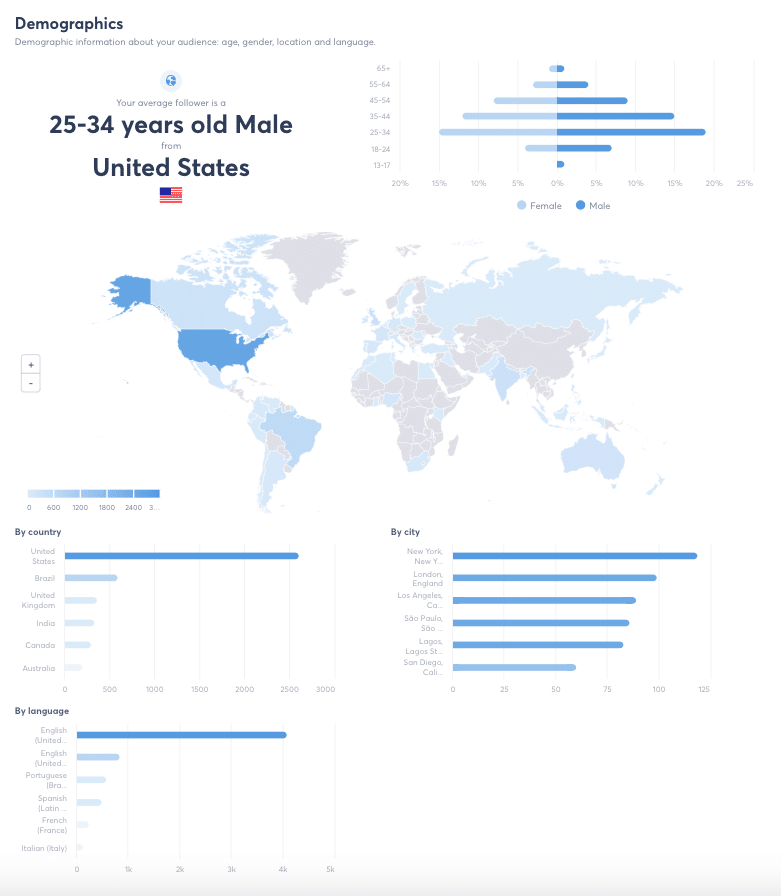
In Agorapulse, you can view specifics about your audience breakdown including age, gender, and location.
This report is available for Facebook, Instagram, LinkedIn, and TikTok, as long as you have more than 100 followers on the platform. This data is useful because it offers a bit more detail to help you better tailor your content and messaging for each platform. For instance, Instagram’s younger, visually-oriented audience responds better to high-quality images and engaging stories, while LinkedIn’s professional users prefer informative and industry-specific content.
2. Different algorithms
Another reason that customizing your content is important is because of the different algorithms that are at work behind the scenes on each social platform. Social media platforms use these algorithms to determine which content gets shown to users. Each algorithm favors different criteria, which is a big part of the reason why using the exact same post for all platforms doesn’t work.
Here’s a high-level overview of each algorithm:
Facebook Algorithm
According to Meta’s website, the algorithm aims to show its users the content that it believes to be most relevant to them. This is determined by looking at signals like the recency of the post, the type of content, and the user’s past interactions with similar content. It also favors posts from your connections with high engagement over content from Pages.
Key Points:
• Prioritize meaningful interactions.
• Use content that encourages interaction and engagement
• Keep content fresh and relevant.
Instagram Algorithm
According to Instagram, each part of the app uses a different algorithm, so the one used for your Feed, isn’t the same as the one used for Stories or Reels. They do all consider things like the user’s interaction history with similar content, the relationship between the user and the poster, and they also ensure the content meets their Community Guidelines. Though this hasn’t been said by Instagram officially, it is widely thought known that Reels are given significant visibility by the Instagram algorithm.
Key Points:
• Engage with high-quality visuals and compelling stories.
• Use Reels for trending topics.
• Build strong relationships with followers.
LinkedIn Algorithm
LinkedIn’s algorithm prioritizes professional and informative content. It favors posts that spark conversations and professional engagement. The algorithm considers the relevancy of the content to the user’s industry, the professional connection between the user and the poster, and the user’s past engagement with similar content.
Key points:
• Share industry insights and thought leadership.
• Don’t just post, but comment and interact with others in your network.
• Focus on insights within your expertise and niche.
TikTok Algorithm
TikTok’s algorithm is designed to surface content that is engaging and keeps users on the app longer. It considers user interactions (likes, comments, shares), video information (captions, sounds, hashtags), and even device/account settings. Videos that quickly gain traction and have high completion rates are likely to be shown more.

Key Points:
• Create engaging, short-form videos.
• Participate in trends and challenges (if it makes sense for your brand).
• Optimize captions, sounds, and hashtags.
Twitter/X Algorithm
Twitter’s algorithm prioritizes recency, relevance, and user engagement. It surfaces tweets that are recent, relevant to the user’s interests, and have high engagement. The algorithm also considers the user’s interactions with the poster and the content type (text, image, video).
Key Points:
• Post timely and relevant content.
• Use hashtags and trending topics.
• Encourage retweets and replies.
Pinterest Algorithm
Pinterest’s algorithm will show Pins on your home feed based on the creators you follow, and your boards, topics, and browsing history. The algorithm considers the quality of the pin, the user’s previous interactions with similar content, and the engagement rate of the pin.
Key Points:
• Create high-quality, visually appealing Pins.
• Use SEO to optimize Pins with relevant keywords.
• Repin and engage with other content.
YouTube Algorithm
YouTube actually has more than one algorithm. But they all seem to consider factors like watch time and user engagement. surfaces videos that keep users watching longer and interacting with the content (likes, comments, shares). The algorithm also considers the relevance of the video to the user’s interests, the users previously watched videos, and the video’s overall performance on the platform.
Key Points:
• Produce long-form, engaging content.
• Use SEO to optimize video titles, descriptions, and thumbnails.
• Create video playlists to keep users on your channel
3. Different Platform Features and Content Formats
The other reason to customize your social posts is to take advantage of the unique features and content formats that are available on each network. I mean, what would Instagram be without Reels, or Twitter without threads?
They probably wouldn’t be as fun … and they likely wouldn’t be as engaging either. The unique features and formats that have been developed for each platform are there for a reason. That is because they keep users interested and on the platform! So by using these platform specific features and content types, you are more likely to encourage high engagement and interaction from your audience.
And you certainly don’t have to miss out on using these different features or content formats just because you are posting from a third-party tool. Using Agorapulse, you can do things like:
- Create and schedule Twitter threads
- Add shoppable product tags to your Instagram posts
- Add Link Stickers to your Stories
- Publish PDF carousels to LinkedIn
- Upload YouTube Shorts
And so much more. And if you want to see for yourself, you can start using Agorapulse today for free.
How to Streamline Content Customization
Now with all these different factors at play on each social network, it’s obvious that customizing your content is a non-negotiable if you want to have any success. But unless you have a body double or a large social media team, it isn’t realistic to create totally different content for each platform every time you post. Nor is it really a good use of your time either. It is far more efficient and effective to simply create one piece of content, alter it to be tailored to each platform, and schedule all from the same app. (And we can totally help you do that.)
Making modifications for each social network
If you want to create one post bound for several social networks, Agorapulse makes it easy for you to make changes to your post for each network. In the publishing window, simply click on the profile you want to make specific changes to and make your changes. For example, you could add a LinkedIn First Comment, tag a location on Twitter, and add a hashtag (or 20) on Instagram—anything you want to customize in your post can be done from one screen.
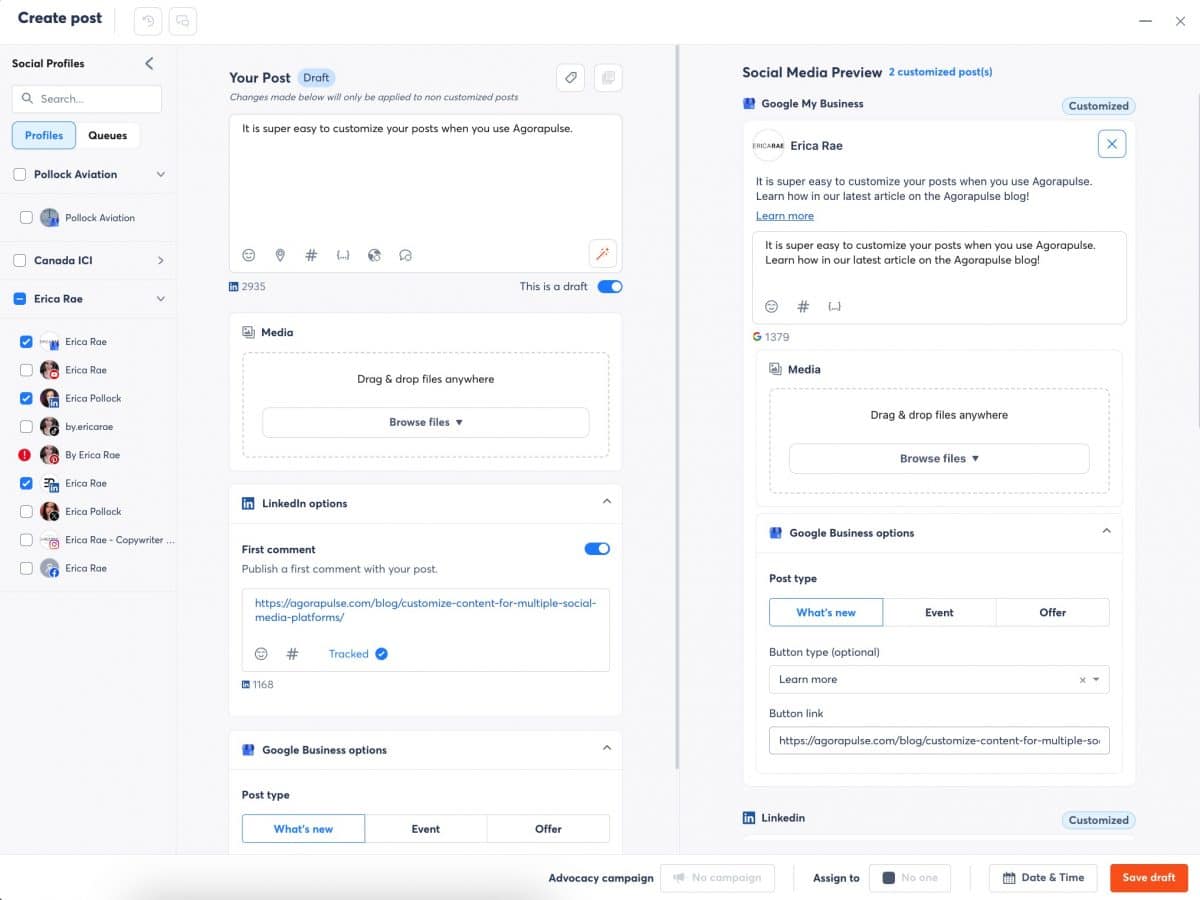
In Agorapulse, modifying a single post so it works on multiple social media platforms is a huge time-saver for your social media publishing process.
Then, when you are done customizing each post, it’s super easy to schedule each one to publish at a specific day and time, or you can have them all publish at once – the choice is yours.
But wait, because it gets even better.
Agorapulse has tons of other features that will save you time when customizing and creating your content.
Some of my favorites are:
• AI Writing Assistant: Enter your initial copy, apply a filter, and watch as Agorapulse’s AI writing assistant enhances it for you. (This is an advanced Agorapulse feature.)
• Content Library: Store images, videos, and drafts in the Agorapulse Library. Group assets by clients or campaigns with custom folders and labels to make it easy to find.
• Content Queues & Bulk Publishing: Schedule up to 200 posts with a single .csv file upload.
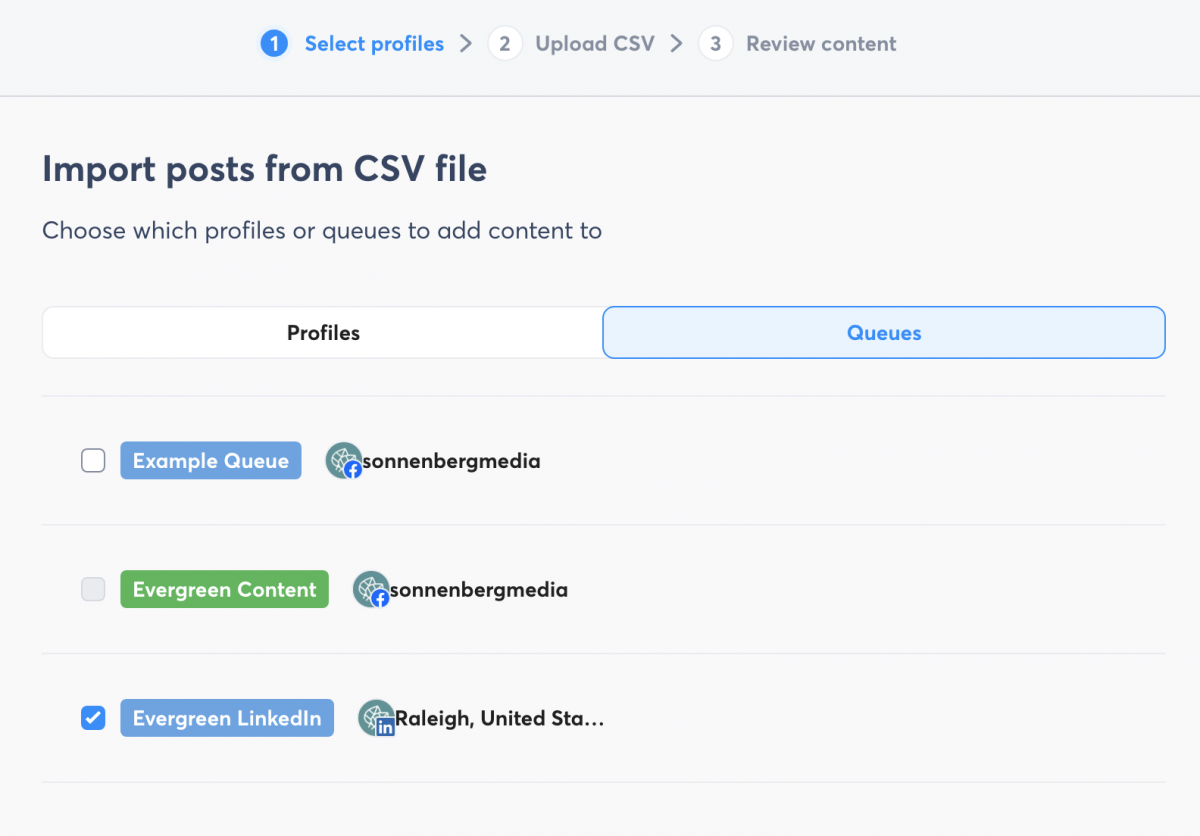
You can upload up to 200 posts using a .csv file with Agorapulse. Not only that, but you can set Queue Categories, meaning you can have certain types of content go out on specific days of the week and times of day.
• Custom Fields: Schedule multiple posts and add customized text to each post quickly using custom fields. (This is particularly handy for companies with multiple store locations.)

• Integrations: Agorapulse has tons of integrations with other platforms you probably already use. For example, when using our Google Drive integration, you can quickly add assets that are stored elsewhere, so you don’t have to waste time downloading each one to your computer first. And with our Canva integration, you can create brand new graphics to use in your post, without even leaving the publishing window.
Final Thoughts on Content Customization
Customizing your content for each social media platform isn’t a best practice anymore—it’s become a necessary piece of the puzzle if you want to maximize your engagement and reach. And with a bit of effort and creativity (and some help from Agorapulse) you can ensure that your posts make an impact and truly connect with your audience, no matter the platform.
Ready to grow your audience on social? Get started today with a free trial of Agorapulse – no credit card needed and no strings attached.
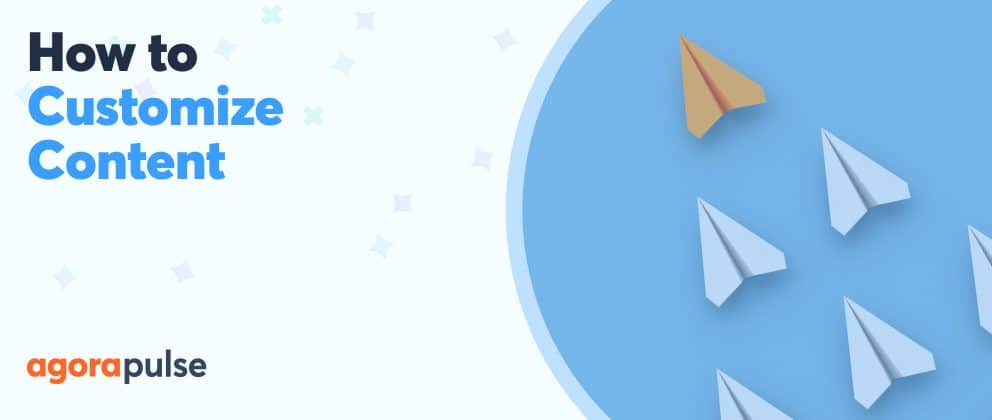


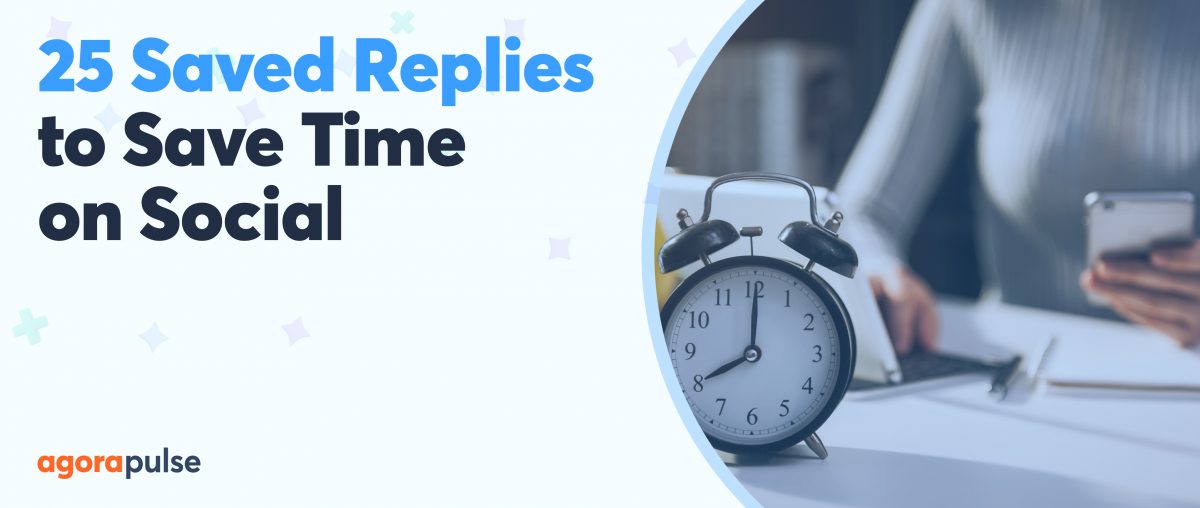
![Feature image of Social media image sizes for all platforms [2025 update] Feature image of Social media image sizes for all platforms [2025 update]](https://static1.agorapulse.com/blog/wp-content/uploads/sites/2/2021/09/Social-Media-Sizes-for-2024-Blogpost-Header-1200x508.jpg)
